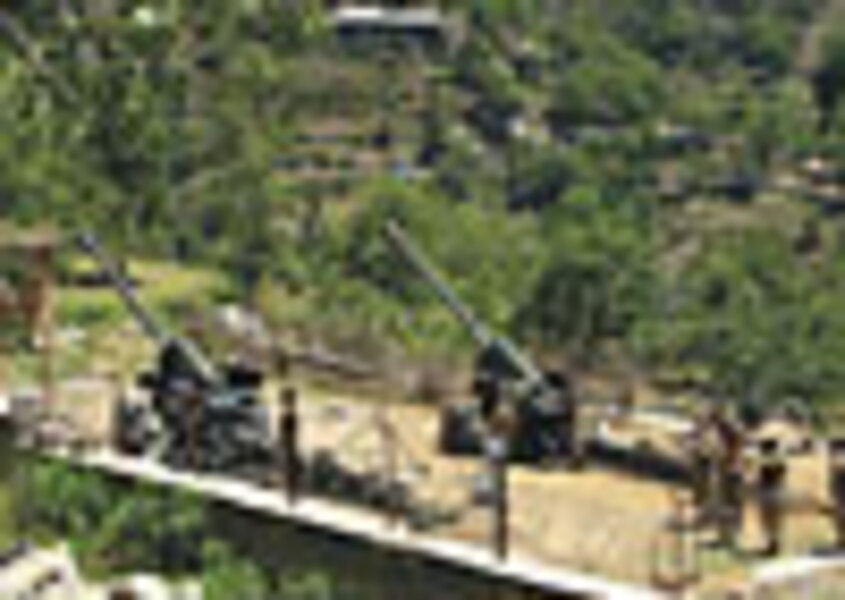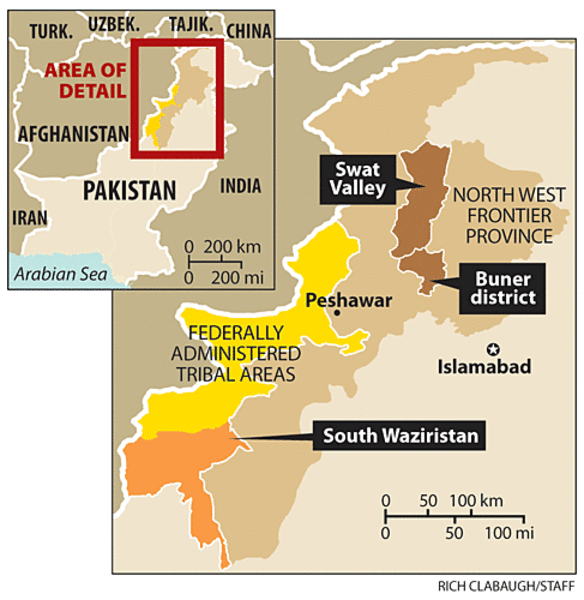Pakistan faces limits as it widens war on Taliban
| New Delhi
The Pakistani military is preparing to open a new front in its fight against the Taliban, this time targeting South Waziristan, a tribal region and home base for Taliban factions fighting the Pakistani state.
In recent days, it has launched softening-up operations, including air raids and shelling.
The military has the momentum of battlefield gains and popular support after pushing back one Taliban faction in northwestern Swat Valley and nearby areas.
But South Waziristan is no Swat.
The tougher terrain, more entrenched foe, and stretched forces lead experts to suspect that this operation will adopt modest aims, not a fight to the finish between Pakistan and the wider Taliban movement.
"We still aren't clear who the Pakistani military is fighting. Are they only fighting the Taliban who are actively fighting Pakistan, or will this go on to fight everybody who is with the Taliban and maybe fighting in Afghanistan?" says Moeed Yusuf, a security analyst at Boston University. "The public sentiment is surely with them at this point, but it's only with them for getting Pakistan back in order, not Afghanistan."
"Taliban" has become an umbrella term for numerous armed factions within both Pakistan and Afghanistan. Some of the Taliban within Pakistan have merely used the country as a base for attacks into Afghanistan.
A few Taliban leaders, including Maulana Fazlullah in Swat and Baitullah Mehsud in South Waziristan, have launched attacks within Pakistan – apparently triggering this military crackdown. Mr. Mehsud is a prime target for this operation, with Army chief Gen. Ashfaq Kayani saying this week that he "must be eliminated."
Broad goals vs. lower expectations
Interior Minister Rehman Malik stated sweeping goals in Islamabad on Monday: "We continue to fight until the last Taliban, militant, enemy of Pakistan is flushed out of Pakistan."
But rather than destroy Mr. Mehsud and his network entirely, the Pakistani military might try instead to redirect his efforts toward Afghanistan, says Seth Jones, an analyst at the RAND Corp.
For the Pakistani military, says Mr. Jones, "an ideal endgame may be to push enough back on Baitullah Mehsud that he continues to focus on his support base in South Waziristan and he turns westward into Afghanistan as his primal area."
He cites two reasons. First, there are elements within the military that support the Taliban fight in Afghanistan.
Second, past fighting in the mountainous tribal belt, including most recently in Bajaur, has proved extremely tough.
"For them to actually target, and try and dismantle, the entire Baitullah Mehsud network and clear huge chunks of South Waziristan, would be a much tougher fight than they are interested in getting into," says Jones.
Mr. Yusuf agrees that the terrain of South Waziristan and the military's own objectives will probably make this operation less extensive than the one in Swat – though it could send comparable numbers of residents fleeing from their homes. Already, thousands of residents have fled South Waziristan in anticipation of the offensive – adding to the more than 2 million people displaced from Swat.
On top of pre-offensive skirmishes, residents also must avoid unmanned airstrikes launched periodically by the United States to target suspected militants. One such drone fired missiles in South Waziristan Thursday, killing at least nine people.
Still tied down in Swat
The scope of the Pakistani military operation in South Waziristan might also be bounded by the tasks ahead in Swat. Operations in both places simultaneously may overtax the country's limited aircraft and helicopter capacity, says Ikram Sehgal, editor of the Defence Journal.
The country also faces a shortage of capable paramilitary and police forces that can step in to cleared areas to keep the Taliban out and encourage residents to return. For this reason, Army spokesman Gen. Athar Abbas expects that the military will need to remain in Swat well after the main fighting ends.
The military could get bogged down if it is saddled with holding territory regained in Swat, Buner, and other districts and agencies that have seen recent fighting like Dir and Bannu.
"The question that remains to be seen is how much are [the military] going to hold and how much are they going to be asked to do in terms of civilian administration," says Yusuf. "The more they are asked to do in civilian administration, it puts pressure on the military, [preventing it] from doing much more."






